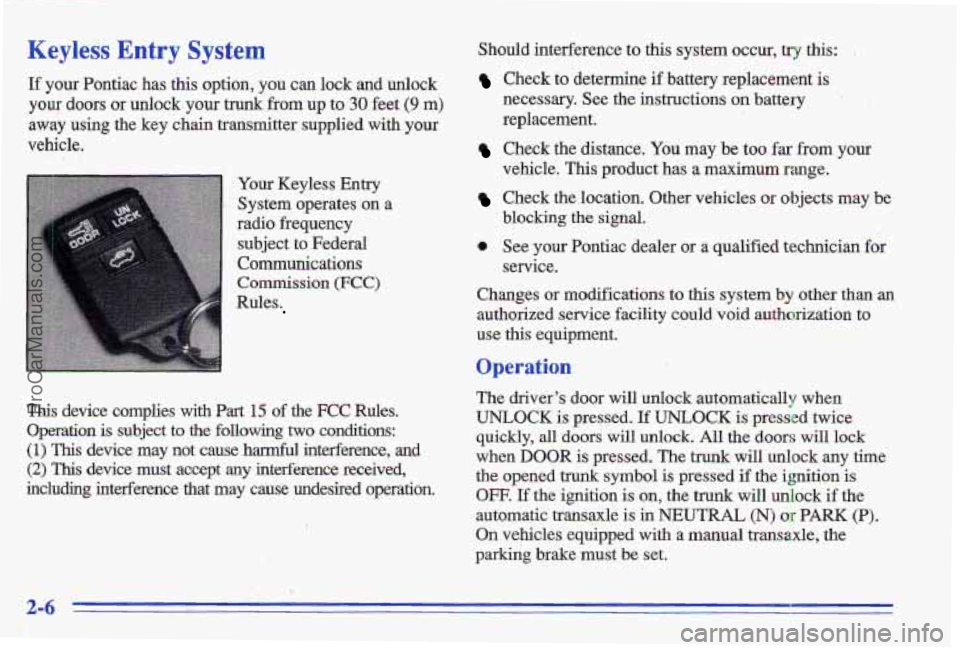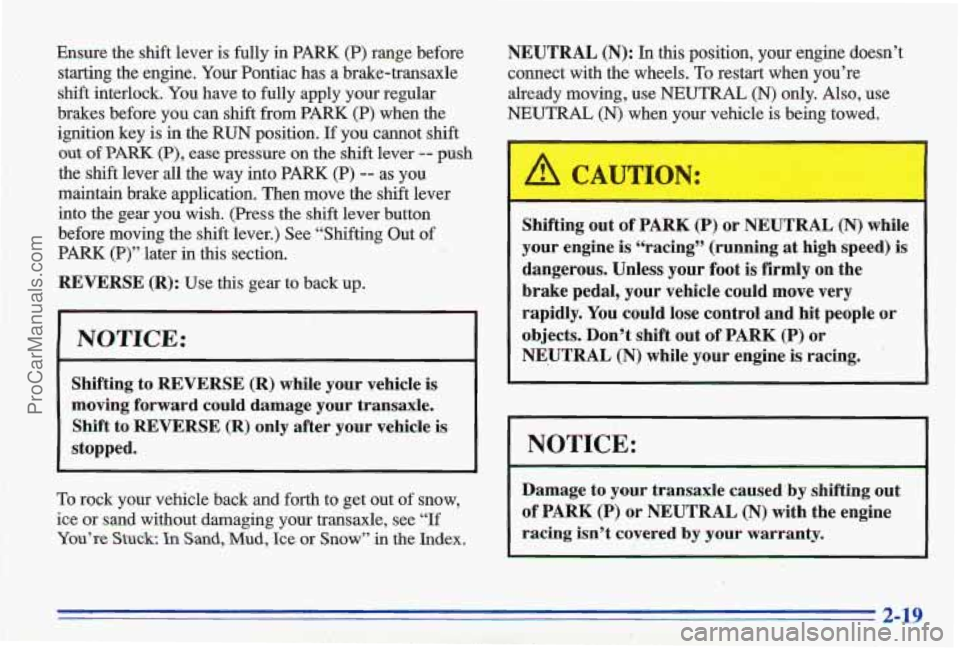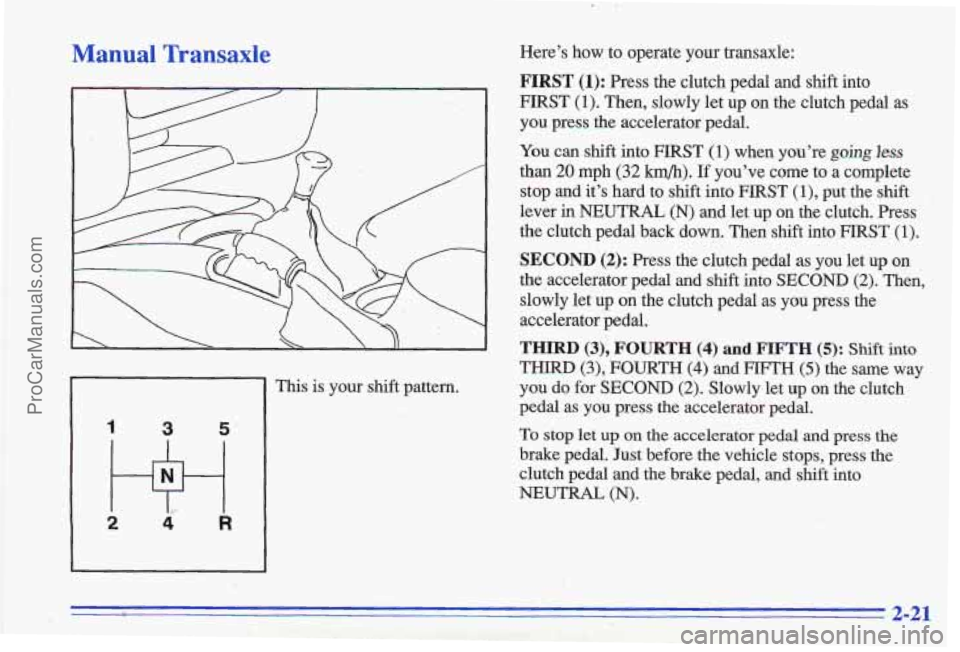Page 7 of 356
For example,
these symbols
me used on an
original battery:
POSSIBLE A
CAUTION
INJURY
PROTECT EYES BY
SHIELDING
CAUSTIC
ACID COULD BAllERY
CAUSE
BURNS
AVOID
SPARKS OR FLAMES
FLAME
EXPLODE BAllERY
These symbols
are important
for you and
yorr passengers
whenever your
vehicle is
driven:
DOOR LOCK
UNLOCK
FASTEN SEAT
BELTS
Vehicle Symbols
These are some of the symbols you may find on your vehicle.
Op
AIR BAG p
These symbols
have
to do with
your lights:
SIGNALS e
TURN
PARKING
pf
LAMPS
RUNNING
' ' 0
DAYTIME *
LAMPS *
FOG LAMPS $0
These symbols
are
on some of
your controls:
WINDSHIELD
DEFROSTER
WINDOW
DEFOGGER
VENTILATING FAN
These symbols are used on
warning and
indicator lights:
ENGINE k
COOLANT - rd
TEMP -
BRAKE (0)
ENGINE OIL
PRESSURE
ANTI-LOCK
(e)
BRAKES
Here are some
other symbols
you may
see:
FUSE
LIGHTER
m
HORN )tr
SPEAKER
b
il'
FUEL
V
ProCarManuals.com
Page 62 of 356

Keyless Entry System Should interference to this system occur, try this:
If your Pontiac has this option, you can lock and unlock Check to determine if battery replacement is
your doors or unlock your trunk from up to 38 feet (9 m) necessary. See the instructions on battery
away
using the key chain transmitter supplied with your replacement.
vehicle.
Check the distance. You may be too far from your
Your Keyless Entry
System operates on a
radio frequency subject to Federal
Communications
Commission (FCC)
Rules
This device complies with Part 15 of the FCC Rules.
Operation is subject to the following two conditions:
(1) This device may not cause harmful intederence, and
(2) This device must accept any interference received,
including interference that may cause undesired operation. vehicle.
This product has a maximum range.
Check the location. Other vehicles or objects may be
blocking the signal.
0 See
your Pontiac dealer OF a qualified twhnicim for
service.
Changes or modifications to this system
by other than an
authorized service facility could void authorization to
use this equipment,
Operation
The driver's door will unlock automatically when
UNLOCK is pressed. If UNLOCK is pressed twice
quickly, all
doors will unlock. All the doors will lock
when
DOOR is pressed, The trunk will unlock any time
the opened trunk symbol is pressed if the ignition is
OFF. If the ignition is on, the trunk will unlock if the
automatic tramaxle
is in NEUTRAL (N) or PARK (P).
On vehicles equipped with a manual transaxle, the
parking brake must be set.
ProCarManuals.com
Page 67 of 356
New Vehicle.“Break-In” Ignition
Switch
NOTICE:
Your modern Pontiac doesn’t need an elaborate
“break-in.” But it will perform better in the long
run if you follow these guidelines:
0
0
0 Don’t drive at any one speed -- fast or
slow
-- for the first 500 miles (804 km).
Don’t make.ful1-throttle starts.
Avoid making hard stops
for the first
200 miles (322 km) or so. During this time
your new brake linings aren’t yet broken
in. Hard stops with new linings can mean
premature wear .and earlier replacement.
Follow
this breaking-in guideline every
time you get new brake linings.
Don’t tow
a trailer during break-in. See
“Towing
a Trailer” in the Index for more
information.
C
A E
W
With the key in the ignition switch, you can turn the
switch
to five positions.
ACCESSORY (A): This position lets you use things
like the radio and windshield wipers when the engine is
off. To use ACCESSORY, push in the key and turn it
toward
you. Your steering wheel will stay locked.
..
ProCarManuals.com
Page 74 of 356

Automatic Transaxle Operation
Your Grand Am may be.equipped with a four-speed
automatic transaxle. The shift lever
is located on the
console between the seats. i
P
R
N
ID1
3
2
1
There are seven different
positions
for the shift lever
on the four-speed
autom&ic transaxle.
PARK (P): This locks your front wheels. It’s the best
position to use when you start your engine because your
vehicle can’t move easily.
It is dangerous to get out of your vehicle if the
shift lever
is not fully in PARK (P) with the
parking brake firmly set. Your vehicle can roll.
Don’t leave your vehicle when the engine is
running unless you have to, If you have left the
engine running, the vehicle can move suddenly.
You or others could be injured. To be sure your
vehicle.won’t move, even when
you’re on fairly
level ground, always set your parking brake and
move the shift lever to PARK (P).
See &‘Shifting Into PARK,(P)” in the Index, Tf
you’re pulling a trailer, see “Towing a in
the Index.
2- 18
ProCarManuals.com
Page 75 of 356

I
Ensure the shift lever is fully in PARK (P) range before
1 ’. I . starting the engine. Your Pontiac has a brake-transaxle !’ 2 . shift interlock. You have to fully apply your regular
brakes before you can shift from PARK (P) when the
ignition key is in the
RUN position. If you cannot shift
out of PARK (P), ease pressure on the shift lever -- push
the shift lever all the way into PARK
(P) -- as you
maintain brake application. Then move the shift lever
into the gear you wish. (Press the shift lever button
before moving the shift lever.) See “Shifting Out
of
PARK (I?)” later in this section.
REVERSE (R):
Use this gear to back up.
NOTICE:
Shifting to REVERSE (R) while your vehicle is
moving forward could damage
your transaxle.
Shift to REVERSE (R) only after your vehicle
is
stopped.
To rock your vehicle back and forth to get out of snow,
ice or sand without damaging your transaxle, see
“If
You’re Stuck: In Sand, Mud, Ice or Snow” in the Index. NEUTRAL
(N):
In this position, your engine doesn’t
connect with the wheels.
To restart when you’re
already moving, use
NEUTRAL (N) only. Also, use
NEUTRAL (N) when your vehicle is being towed.
I
Shifting out of PARK (P) or NEUTRAL (N) while
your engine
is “racing” (running at high speed) is
dangerous. Unless your foot is firmly on. the
brake pedal, your vehicle could move very
rapidly.
You could lose control and hit people or
objects. Don’t shift out of PARK
(P) or
NEUTRAL
(N) while your engine is racing. .
NOTICE:
Damage to your transaxle caused’by shifting ‘out
of PARK
(P) or NEUTRAL (N) with the engine
racing isn’t covered
by your warranty.
ProCarManuals.com
Page 77 of 356

Manual Transaxle
1 3 5’
2 Hi 4 R
This is your shift pattern.
.. .- . 2;.
Here’s how to operate your transaxle:
FIRST (1): Press the clutch pedal and shift into
FIRST (1). Then, slowly let up on the clutch pedal
as
you press the accelerator pedal.
You can shift into FIRST
(1) when you’re going less
than 20 mph (32 km/h). If you’ve come to a complete
stop and it’s hard to shift
into FIRST (1)’ put the shift
lever
in NEUTRAL (N) and let up on the clutch. Press
the clutch pedal back down. Then shift into FIRST (1).
SECOND (2): Press the clutch pedal as you let up on
the accelerator pedal and shift into
SECOND (2). Then,
slowly let up
on the clutch pedal as you press the
accelerator pedal.
THIRD (3), FOURTH (4) and FIFTH (5): Shift into
THIRD
(3), FOURTH (4) and FIFTH (5) the same way
you do for
SECOND (2). Slowly let up on the clutch
pedal as you press the accelerator
pedal.
To stop let up on the accelerator pedal and press the
brake pedal. Just before the vehicle stops, press the
clutch pedal and the brake pedal, and shift into
NEUTRAL (N).
ProCarManuals.com
Page 78 of 356
NEUTRAL '(N): Use this position when you start or
idle your engine.
REVERSE (R): To back up, press down the clutch
pedal and shift into REVERSE (R). Let up on the clutch
pedal slowly
while pressing the accelerator pedal.
'1 NOTICE:
Shift to REVERSE (R) only after your vehicle is
stopped. Shifting to REVERSE (It) while your
vehicle is moving could damage your transaxle.
..
1
Also, use WVERSE (R), along with the parking brake,
for parking your vehicle.
Shift Speeds
I A CAUTION:
If you skip more than one gear when you
downshift, you could lose control of your vehicle.
And you could injure yourself or others. DonY
shift from
FIFTH (5) to SECOND (2) or from
FOURTH (4) to FIRST (1).
This chart shows when to shift to the next higher gear
for best
fuel economy.
ProCarManuals.com
Page 80 of 356
Parkiaag.’Brake handle. If the ignition is on, the brake system warning
light will come on.
To release the parking brake hold the regular brake
pedal down. Pull
the parking brake lever up until you
can press the release button. Hold the release button in
as you move the brake lever all the way down.
Driving with the parking, brake on can cause
your rear brakes to overheat. You may have to
replace them, and you could also damage other
To set the parking brake hold the .regular brake pedal If you are towing a trailer and are parking on my hill,
see “Towing
a Trailer” in the Index. That section shows
down with Your ‘ght foot* On the parking brake what to do first to keep the bailer from moving.
2-24
ProCarManuals.com